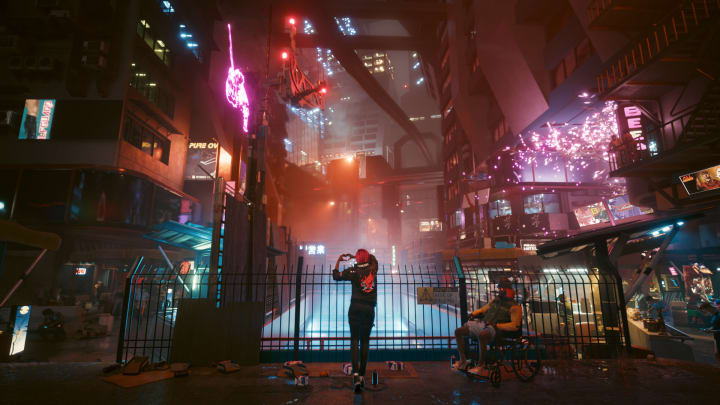Interview: What Unreal Engine means for the next Cyberpunk and The Witcher games

While CD Projekt Red worked on upgrading its in-house RPG engine for Cyberpunk 2077, the developers strapped GoPro cameras to their chests to imagine a sci-fi world played from the first-person perspective. A controversial decision in the lead-up to launch, this switch in perspective from the studio’s previous game – the third-person RPG The Witcher 3 – was key to the themes it wanted to explore.
Cyberpunk 2077 takes place in a future world where people purposely lop off limbs and tear away their flesh to replace their God-given bodies with man-made tech. It wants you to question what makes us human, and whether the soul is caged to our physical form. Questions best pondered while embodying someone else entirely, where you can look down at your limbs and see how much you’ve changed.
“When you click a chair to sit, you never see [protagonist] V sit with the camera,” associate game director Paweł Sasko tells me when I chat with him at Gamescom LATAM. “You see the arm goes first, then you see the body, then the body goes from the arm, then you sit down – there's always body presence, as we call it.”
CD Projekt spent over a year filming these shorts to figure out how player interactions should look in-game, from sipping a drink at a bar to leaning from a vehicle window to fire a pistol. Meticulous planning went into figuring out where to cut, how to do it, and how the character rig should move through each frame.
Much of the work done on Cyberpunk 2077 was like this – figuring out how to make a new type of game. Seven years ago, CDPR got a $7 million research grant from the Polish government to look into new technologies such as 'Seamless Multiplayer' and 'City Creation'. As we now know, the first of those didn’t work out. The second did.
The Red Engine that built The Witcher 3 had to be completely stripped down and rebuilt to cater for a large, densely populated city you can tear through on a motorbike. With such a long, arduous development process and so much work put into creating an engine to power the game alongside the game itself, it’s surprising that CDPR has decided to ditch its engine in favor of Unreal Engine 5 for the next Witcher and Cyberpunk games.
To understand why, we have to go back to the start. The first Witcher game was developed in an engine called Aurora, which the studio licensed from BioWare. However, Aurora didn’t have the functionality to do everything CDPR wanted to achieve, such as more unique landscapes (rather than repeating tiles), motion-captured animation, and better lighting systems. So the studio tweaked and tweaked until Aurora became something else entirely. The studio called the altered engine “Genie”.
For The Witcher 2, CDPR made the first version of its proprietary engine, Red Engine 1. This engine was then upgraded to get The Witcher 2 running on Xbox 360, marking the first time the studio had released a game on console. For The Witcher 3, the engine was essentially remade. It became Red Engine 3.
“Every time, we have almost started from scratch,” Sasko says. “We transfer the knowledge of how the toolset works, what works when it comes to the structural build of the game – it's the institutional knowledge that is in the minds of your people. So all of those things could be moved from engine to engine to engine to engine.”
With Unreal Engine, CDPR is opening up its studio to the institutional knowledge of an entire industry. Most game developers are experienced with Unreal to some extent with it being the dominant engine on the market, and it’s notoriously user-friendly. Switching to something more widely used allows CDPR to snatch up talent globally, which aligns with its new studio opening in Boston, North America.
According to Sasko, the engine switch doesn’t necessarily mean the studio is leaving the technology it has developed behind, either. “Some technology will move forward,” Sasko says. “It's a matter of exactly what you can do. I cannot go into more detail because I will have to go into the design of our future games, which I cannot do.”
Another advantage of Unreal, Sasko says, is how it allows you to buy asset packs on the marketplace. While the studio will make all of its own assets from scratch for its full releases, this speeds up the prototyping process, allowing the studio to quickly create scenes and visualize how they will look once the artwork is done.
CDPR has always been an industry leader pushing technological boundaries with its games, from twisting BioWare’s Aurora engine to implementing full path tracing in Cyberpunk 2077. The starting point might be Unreal Engine 5, but it’s exciting to imagine just what CDPR will do with it. Unless you’ve got a GoPro camera that can see into the future, we’ll have to wait and see – there’s no visualizing this switch up ahead of time.
